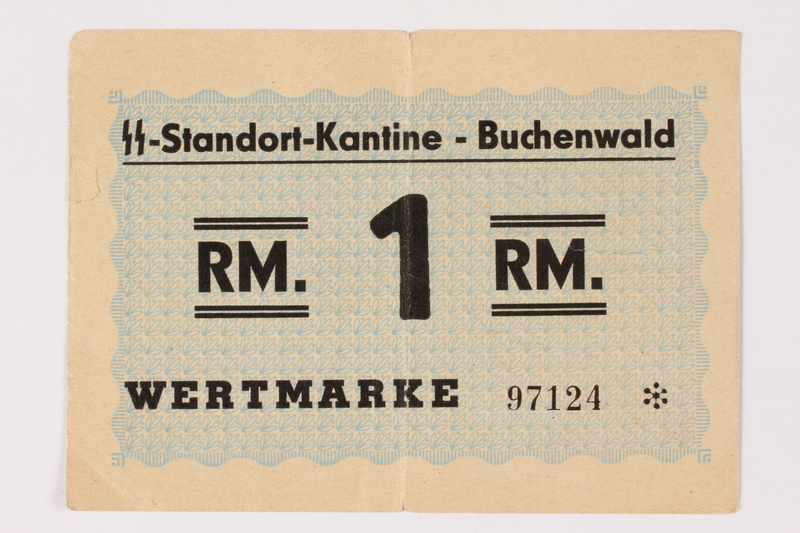Overview
- Brief Narrative
- Buchenwald canteen coupon, 1 Reichsmark, issued to Moses Silberberg between February 10 to April 11, 1945, when he was imprisoned in Buchenwald concentration camp in Germany. Buchenwald issued undated notes in 0.5, 1, 2, and 3 mark denominations. There were two types: canteen scrip and exchange scrip issued to members of outside labor brigades. On September 6, 1939, the German Army entered Moses’s town, Konskie, Poland. In spring 1941, Moses and his parents, Berek and Matla, were interned in the ghetto. In October 1942, Moses, Berek, and Matla left for Krakow ghetto. Moses was a slave laborer in Krakau-Płaszów concentration camp. On March 13 and 14, 1943, the ghetto was liquidated and Berek and Matla were sent to Auschwitz-Birkenau killing center. On February 5, 1944, Moses was sent to Auschwitz concentration camp. The camp was evacuated on January 18, 1945, and Moses was sent on a death march to Gross-Rosen in Germany. In February, he was sent to Buchenwald where he was liberated by US soldiers on April 11, 1945. In June, Moses was sent to recuperate at a displaced persons camp in Switzerland. He then lived in Bergen Belsen displaced persons camp. Nearly his entire extended family was killed during the war. Moses married a fellow survivor, Estera Jaeger, and they settled in Switzerland.
- Date
-
use:
1945 February 10-1945 April
- Geography
-
use:
Buchenwald (Concentration camp);
Weimar (Thuringia, Germany)
- Credit Line
- United States Holocaust Memorial Museum Collection, Gift of Moses Silberberg, in memory of my parents, grandparents, and my 75 related family members who were killed by the Germans
- Markings
- front, top, black ink : two SS lightning bolts -Standort-Kantine - Buchenwald
front, center, black ink : RM. 1 RM.
front, bottom, black ink : WERTMARKE / 97124 / ✽ - Contributor
-
Subject:
Moses Silberberg
- Biography
-
Moses Silberberg was born ca. June 12, 1912, in Konskie, Russia (now Poland) to Berek and Matla Goldberg Silberberg. Berek, a grocer, was born in 1889, in Wolbrom, Russia (Poland), to Shlomo and Chaia Silberberg. Matla was born in 1891, in Konskie, to Jacob and Chava Goldberg. Moses’s family lived in an apartment above the grocery store owned by his father. Moses attended a local Jewish day school and helped his parents at the store. The family was very observant and practiced Hasidic Judaism. When he was about ten, Moses went to live with his paternal grandparents in Wolbrom, so his grandfather, a rabbi, could help him prepare for his bar mitzvah. When Moses returned to Konskie, he studied at the local yeshiva until he graduated. Moses’s grandmother Chava Goldberg died. In 1937, there was a Polish boycott of Jewish businesses, though many of the Silberberg’s Polish customers continued to shop at the store.
On September 1, 1939, Germany invaded Poland. A week later, a group of German soldiers broke into the Silberberg's store and robbed it. On the 15th, soldiers returned and padlocked the store. Later that night, Moses and his parents snuck in and took food and supplies back to their apartment. The next day, more soldiers came to empty out the store. Anything they did not want, they threw into the street for Polish people to take. Soldiers began rounding up Jewish men and taking them to a nearby factory. Moses and his father Berek hid in a small room in their apartment, which was hidden behind furniture. Soldiers came looking for them, but Matla said they were away, fighting in the war. The men in the factory were given no food or water and were taken away each night. In early October, the soldiers burned down the 500 year old synagogue near Moses’s apartment. Not long after, four Germans were killed by Polish soldiers, who falsely accused Jews as the perpetrators. As retribution, German soldiers selected a group of seventy Jews, including Moses’s grandfather Jacob Goldberg. The group was arranged around a large grave in the park and shot. A Judenrat [Jewish council] was established to manage the Jewish population in town for the Germans. Moses and Berek stopped hiding and registered with the Judenrat for forced labor.
In spring 1941, a ghetto was established. The family was able to stay in their home since it was within the ghetto, though they were forced to share with another family. Moses’s neighbors received travel papers from relatives and went to the Krakow ghetto. In June 1942, a family friend overheard German soldiers talking about sending people away on trains and killing them. He warned Moses’s family about this and Moses’s parents asked their former neighbors in Krakow for help. In October, their neighbors supplied travel papers for the Silberberg family and they left Konskie. In Krakow, Moses’s parents were placed in the main ghetto, with those who could not work. Moses was placed in a separate area and assigned to work on the construction of Krakau-Płaszów labor camp. He was a roofer. Moses paid a camp kapo to let him see his parents daily. In winter 1943, Moses was moved to the recently completed camp barracks. The guards and camp commander, Amon Göth, regularly shot and beat prisoners. Once, while working outside the camp, a prisoner in Moses’s work group ran away and the group was one person short during roll call. As punishment, Göth had all the camp prisoners watch as every tenth person in Moses’s group was shot. On March 13 and 14, Krakow ghetto was liquidated and Moses’s parents were put onto a transport train.
In January 1944, Krakau-Płaszów was redesignated a concentration camp, though it had been like one for a long time. On February 5, Moses and other skilled laborers were transported to Auschwitz concentration camp. When he arrived, he was forced to shower, issued a uniform, and quarantined. He was assigned prisoner number, 174149, which was tattooed on his forearm. Six and a half days a week, Moses worked as a carpenter or transported sand and stone. Every six weeks, Moses had to pass an inspection to ensure he was not too skinny or weak to work. On January 18, 1945, as the Soviet Army advanced on the region, Auschwitz was evacuated. Moses was told to go into the houses of the guards and take whatever he could carry in preparation for a forced march through the snow. After a day and a half, Moses arrived at Gross-Rosen concentration camp in Germany. Several days later, he was given half a loaf of bread and placed on an overcrowded transport train. Almost three quarters of the prisoners died during the two day trip. On February 10, Moses arrived at Buchenwald concentration camp. He was forced to strip and wait naked overnight, to shower before being given a new uniform and some bread. Moses was assigned a new prisoner number, 127070, and sent to barracks that had no pillows or padding on the bunks. Moses met an uncle at the camp, and he got Moses transferred to a better barrack with pillows and straw mattresses. Moses was a digger in a work group assigned to a small town 2 miles from the camp. On March 31, the guards began transporting prisoners to other camps. Moses did not want to be relocated, so he and his uncle hid. On April 11, 1945, the camp was liberated by US soldiers.
On May 7, Germany surrendered. In mid-June, Moses was sent to Switzerland to recuperate in a displaced persons camp. In September, he was transferred to a small refugee camp in an old hotel in Lugano. He also lived for a while in the displaced persons camp near the former Bergen Belsen concentration camp. In May 1947, Moses returned to Konskie to recover hidden family possessions. After two days, he went to Łódź to look for relatives. Moses found two cousins and learned that his paternal grandparents had been deported to a killing center. His parents had been killed after arrival at Auschwitz in March 1943. Moses returned to Switzerland and moved to Zurich, where he was a salesman. A friend took Moses to Munich, Germany, and introduced him to a fellow survivor, Estera Jaeger. She was born on April 5, 1923, in Olkusz, Poland, to Abraham Jacob (1899-1944) and Lea Matzna (1898-1943) Jaeger. She had three sisters: Bala (1921-1973), Basia (1925-1943), and Zysla (1927-1943). In 1940, Estera was interned in Sosnowicz ghetto. In January 1942, she was transported to Parschnitz forced labor camp in Porici, Czechoslovakia. On May 9, 1945, the camp was liberated by the Soviet Army. Only she and her sister Bala survived. Moses married Estera and they settled in Zurich. In April 1951, their daughter was born. In April 1954, Moses, Estera, and their daughter sailed to New York City and settled in Brooklyn. Moses became a watch salesman. In June 1956, their son was born. Moses, 84, died on August 30, 1996. Estera, 89, passed away on March 14, 2013.
Physical Details
- Language
- German
- Classification
-
Exchange Media
- Category
-
Money
- Object Type
-
Scrip (aat)
- Physical Description
- Rectangular, light brown paper coupon with a rectangular, pale blue floral background design with scalloped edges and a narrow, blank border printed on the front. German text, the denomination 1, a serial number, and an asterisk are printed in black ink over the floral design. On the back, handwritten in blue pencil, is a column of 7 words, possibly names, covered with crossout lines. The scrip is soiled, with creases and small tears.
- Dimensions
- overall: Height: 3.000 inches (7.62 cm) | Width: 4.125 inches (10.478 cm)
- Materials
- overall : paper, ink, colored pencil
Rights & Restrictions
- Conditions on Access
- No restrictions on access
- Conditions on Use
- No restrictions on use
Keywords & Subjects
- Topical Term
- Concentration camp inmates--Germany--Weimar (Thuringia)--Biography. Concentration camp inmates--Poland--Biography. Holocaust survivors--United States--Biography. Holocaust, Jewish (1939-1945)--Poland--Personal narratives. Jews--Persecution--Poland--Biography. Slave labor--Poland--Krakow--Biography.
- Corporate Name
- Buchenwald (Concentration camp)
Administrative Notes
- Legal Status
- Permanent Collection
- Provenance
- The scrip was donated to the United States Holocaust Memorial Museum in 1992 by Moses Silberberg.
- Funding Note
- The cataloging of this artifact has been supported by a grant from the Conference on Jewish Material Claims Against Germany.
- Record last modified:
- 2023-05-26 10:10:42
- This page:
- https://collections.ushmm.org/search/catalog/irn6897
Download & Licensing
In-Person Research
- By Appointment
- Request 21 Days in Advance of Visit
- Plan a Research Visit
- Request to See This Object
Contact Us
Also in Moses Silberberg collection
The collection consists of a concentration camp uniform cap and trousers, five Buchenwald scrip, documents, and a book relating to the experiences of Moses Silberberg, who was a prisoner in Plaszow, Auschwitz, Gross Rosen, and Buchenwald concentration camps in Poland and Germany during the Holocaust and when living in Germany and Switzerland after the Holocaust.
Date: 1945 February-1946
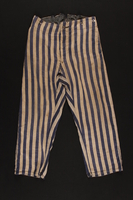
Striped concentration camp uniform trousers worn by Polish Jewish inmate
Object
Striped summerweight concentration camp uniform trousers worn by Moses Silberberg while imprisoned at Buchenwald concentration camp from February 10 to April 11, 1945. On September 6, 1939, the German army entered Moses’s town, Konskie, Poland, and looted his family’s grocery store. In spring 1941, Moses and his parents, Berek and Matla, were interned in the ghetto. In October 1942, Moses, Berek, and Matla left for Krakow ghetto. Moses was a slave laborer in Krakau-Płaszów concentration camp. On March 13 and 14, 1943, the ghetto was liquidated and Berek and Matla were sent to Auschwitz-Birkenau killing center. On February 5, 1944, Moses was sent to Auschwitz concentration camp. The camp was evacuated on January 18, 1945, and Moses was sent on a death march to Gross-Rosen in Germany. In February, he was sent to Buchenwald where he was liberated by US soldiers on April 11, 1945. In June, Moses was sent to recuperate at a displaced persons camp in Switzerland. He then lived in Bergen Belsen displaced persons camp. Nearly his entire extended family was killed during the war. Moses married a fellow survivor, Estera Jaeger, and they settled in Switzerland.
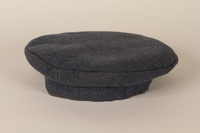
Dark blue concentration camp uniform cap worn by a Polish Jewish inmate
Object
Dark blue concentration camp uniform cap worn by Moses Silberberg while imprisoned at Buchenwald concentration camp from February 10 to April 11, 1945. On September 6, 1939, the German army entered Moses’s town, Konskie, Poland, and looted his family’s grocery store. In spring 1941, Moses and his parents, Berek and Matla, were interned in the ghetto. In October 1942, Moses, Berek, and Matla left for Krakow ghetto. Moses was a slave laborer in Krakau-Płaszów concentration camp. On March 13 and 14, 1943, the ghetto was liquidated and Berek and Matla were sent to Auschwitz-Birkenau killing center. On February 5, 1944, Moses was sent to Auschwitz concentration camp. The camp was evacuated on January 18, 1945, and Moses was sent on a death march to Gross-Rosen in Germany. In February, he was sent to Buchenwald where he was liberated by US soldiers on April 11, 1945. In June, Moses was sent to recuperate at a displaced persons camp in Switzerland. He then lived in Bergen Belsen displaced persons camp. Nearly his entire extended family was killed during the war. Moses married a fellow survivor, Estera Jaeger, and they settled in Switzerland.
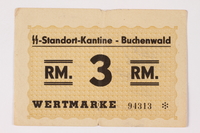
Buchenwald Standort-Kantine concentration camp scrip, 3 Reichsmark, issued to inmate
Object
Buchenwald canteen coupon, 3 Reichsmark, issued to Moses Silberberg between February-April 1945 when he was imprisoned in Buchenwald concentration camp in Germany. Buchenwald issued undated notes in 0.5, 1, 2, and 3 mark denominations. There were two types: canteen scrip and exchange scrip issued to members of outside labor brigades. On September 6, 1939, the German Army entered Moses’s town, Konskie, Poland. In spring 1941, Moses and his parents, Berek and Matla, were interned in the ghetto. In October 1942, Moses, Berek, and Matla left for Krakow ghetto. Moses was a slave laborer in Krakau-Płaszów concentration camp. On March 13 and 14, 1943, the ghetto was liquidated and Berek and Matla were sent to Auschwitz-Birkenau killing center. On February 5, 1944, Moses was sent to Auschwitz concentration camp. The camp was evacuated on January 18, 1945, and Moses was sent on a death march to Gross-Rosen in Germany. In February, he was sent to Buchenwald where he was liberated by US soldiers on April 11, 1945. In June, Moses was sent to recuperate at a displaced persons camp in Switzerland. He then lived in Bergen Belsen displaced persons camp. Nearly his entire extended family was killed during the war. Moses married a fellow survivor, Estera Jaeger, and they settled in Switzerland.
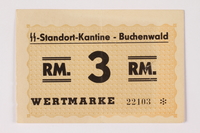
Buchenwald Standort-Kantine concentration camp scrip, 3 Reichsmark, issued to inmate
Object
Buchenwald canteen coupon, 3 Reichsmark, issued to Moses Silberberg between February-April 1945 when he was imprisoned in Buchenwald concentration camp in Germany. Buchenwald issued undated notes in 0.5, 1, 2, and 3 mark denominations. There were two types: canteen scrip and exchange scrip issued to members of outside labor brigades. On September 6, 1939, the German Army entered Moses’s town, Konskie, Poland. In spring 1941, Moses and his parents, Berek and Matla, were interned in the ghetto. In October 1942, Moses, Berek, and Matla left for Krakow ghetto. Moses was a slave laborer in Krakau-Płaszów concentration camp. On March 13 and 14, 1943, the ghetto was liquidated and Berek and Matla were sent to Auschwitz-Birkenau killing center. On February 5, 1944, Moses was sent to Auschwitz concentration camp. The camp was evacuated on January 18, 1945, and Moses was sent on a death march to Gross-Rosen in Germany. In February, he was sent to Buchenwald where he was liberated by US soldiers on April 11, 1945. In June, Moses was sent to recuperate at a displaced persons camp in Switzerland. He then lived in Bergen Belsen displaced persons camp. Nearly his entire extended family was killed during the war. Moses married a fellow survivor, Estera Jaeger, and they settled in Switzerland.
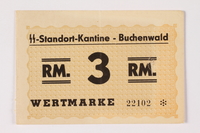
Buchenwald Standort-Kantine concentration camp scrip, 3 Reichsmark, issued to inmate
Object
Buchenwald canteen coupon, 3 Reichsmark, issued to Moses Silberberg between February-April 1945 when he was imprisoned in Buchenwald concentration camp in Germany. Buchenwald issued undated notes in 0.5, 1, 2, and 3 mark denominations. There were two types: canteen scrip and exchange scrip issued to members of outside labor brigades. On September 6, 1939, the German Army entered Moses’s town, Konskie, Poland. In spring 1941, Moses and his parents, Berek and Matla, were interned in the ghetto. In October 1942, Moses, Berek, and Matla left for Krakow ghetto. Moses was a slave laborer in Krakau-Płaszów concentration camp. On March 13 and 14, 1943, the ghetto was liquidated and Berek and Matla were sent to Auschwitz-Birkenau killing center. On February 5, 1944, Moses was sent to Auschwitz concentration camp. The camp was evacuated on January 18, 1945, and Moses was sent on a death march to Gross-Rosen in Germany. In February, he was sent to Buchenwald where he was liberated by US soldiers on April 11, 1945. In June, Moses was sent to recuperate at a displaced persons camp in Switzerland. He then lived in Bergen Belsen displaced persons camp. Nearly his entire extended family was killed during the war. Moses married a fellow survivor, Estera Jaeger, and they settled in Switzerland.
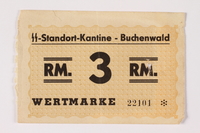
Buchenwald Standort-Kantine concentration camp scrip, 3 Reichsmark, issued to inmate
Object
Buchenwald canteen coupon, 3 Reichsmark, issued to Moses Silberberg between February-April 1945 when he was imprisoned in Buchenwald concentration camp in Germany. Buchenwald issued undated notes in 0.5, 1, 2, and 3 mark denominations. There were two types: canteen scrip and exchange scrip issued to members of outside labor brigades. On September 6, 1939, the German Army entered Moses’s town, Konskie, Poland. In spring 1941, Moses and his parents, Berek and Matla, were interned in the ghetto. In October 1942, Moses, Berek, and Matla left for Krakow ghetto. Moses was a slave laborer in Krakau-Płaszów concentration camp. On March 13 and 14, 1943, the ghetto was liquidated and Berek and Matla were sent to Auschwitz-Birkenau killing center. On February 5, 1944, Moses was sent to Auschwitz concentration camp. The camp was evacuated on January 18, 1945, and Moses was sent on a death march to Gross-Rosen in Germany. In February, he was sent to Buchenwald where he was liberated by US soldiers on April 11, 1945. In June, Moses was sent to recuperate at a displaced persons camp in Switzerland. He then lived in Bergen Belsen displaced persons camp. Nearly his entire extended family was killed during the war. Moses married a fellow survivor, Estera Jaeger, and they settled in Switzerland.
Moses Silberberg collection
Document
The Moses Silberberg collection consists of samples of camp scrip from Buchenwald concentration camp and two copies of "Buchenwald Lied," including the lyrics to several songs sung in the Buchenwald camp by Moses Silberberg and fellow inmates.
Photobook
Object
Book of photographs, Our Destruction in Pictures, acquired by Moses Silberberg, a survivor of four German concentration camps, while living in Bergen-Belsen displaced persons camp after the war. The photographs were collected, annotated, and published by the Central Committee of the Liberated Jews in the British Zone in Bergen-Belsen DP camp in December 1946. The images show scenes of atrocities committed against Jews during the Holocaust, including mass murder, humiliations, such as cutting the hair of religious Jews, forced labor, hangings, and deportations from Germany and Poland, with multiple scenes from Bedzin and Łódź ghettos. From the preface: "When words are too weak and too poor to convey the destruction and extermination of Jewish life, may these pictures, found by accident on arrested S.S. soldiers, speak for themselves of the bestiality which will forever bring shame on human kind."

